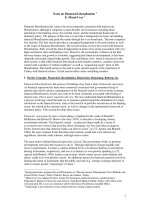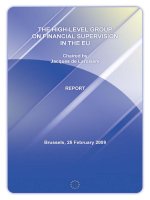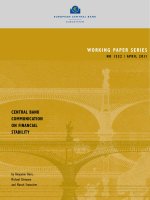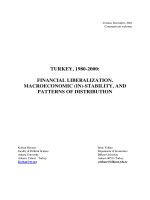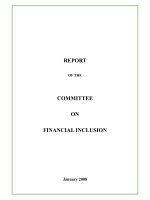Notes on Financial Liberalization 1
Bạn đang xem bản rút gọn của tài liệu. Xem và tải ngay bản đầy đủ của tài liệu tại đây (91.91 KB, 12 trang )
1
Notes on Financial Liberalization
1
E. Murat Ucer
2
Financial liberalization has come to be most commonly associated with interest rate
liberalization, although it comprises a much broader set of measures including those
pertaining to the banking sector, the external sector, and the institutional framework of
monetary policy. The purpose of this note is to provide a background on issues surrounding
financial liberalization and guide the reader through this very broad topic. The note comprises
five sections. The first section provides a conceptual background to the early themes as well
as the scope of financial liberalization. The second section reviews the record with financial
liberalization. Early record has been disappointing in terms of its strong association with very
high real interest rates and banking crises. However, the econometric evidence on the link
between finance and growth is favorable, suggesting that financial development, as has been
originally advocated, indeed helps growth. The conciliatory view, which is discussed in the
third section, is that while financial liberalization does benefit countries, countries need to be
careful with a number of “initial conditions” as well as “sequencing issues” prior to full
liberalization. The fourth section is devoted to some specific aspects of the experience of
Turkey with financial reform. A final section offers some concluding remarks.
I. On the Concepts: Financial Liberalization, Repression, Deepening, Reform, etc.
Financial liberalization is the process of breaking away from a state of financial repression.
As financial repression has been most commonly associated with government fixing of
interest rates and its adverse consequences on the financial sector as well as on the economy,
financial liberalization, in turn, has come to be most commonly associated with freeing of
interest rates. This is pretty much the old view. We now understand financial liberalization as
a process involving a much broader set of measures geared toward the elimination of various
restrictions on the financial sector, such as the removal of portfolio restrictions on the banking
sector, the reform of the external sector, as well as changes in the institutional framework of
monetary policy. This section develops these issues.
Financial repression, by-now a classic phrase, originated in the works of Ronald I.
McKinnon and Edward S. Shaw in the early 1970s, to describe a developing country
environment whereby “the financial system…is repressed (kept small) by a series of
government interventions that have the effect of keeping very low (and often at negative
levels) interest rates that domestic banks can offer to savers” (p.152, Agenor and Montiel,
1996); the most common forms that these interventions would take were interest rate
regulations, directed credit schemes, and high reserve ratios.
The main motive behind financial repression is fiscal. The government wishes to promote
development, but lacks the resources to do so. Through imposition of large liquidity and
reserve requirements, it creates a captive demand for its own interest bearing or non-interest
bearing instruments, respectively, and uses it to finance its own priority spending (p.152,
Agenor and Montiel, 1996). It puts a cap on rates, which creates excess credit demand, and
directs credit to its own priority sectors. An additional means for financial repression involves
limiting the menu of instruments that the public can hold (e.g., foreign exchange deposits) in
order to ensure greater “seigniorage” revenue.
3
1
Background notes prepared for an EDI seminar on “Macroeconomic Management: New Methods and
Current Policy Issues” held in Nairobi, Kenya and Ankara, Turkey.
2
Murat Ucer was Adjunct Faculty, Center for Economics and Econometrics, and Economics
Department, Bogazici University and Advisor, Yapi Kredi Bank, Istanbul, Turkey when these notes
were prepared. He is now an economist with Credit Suisse First Boston, Istanbul Office.
3
Seigniorage is government revenue arising from the issuing of paper money.
2
Financial repression is a problem because, as McKinnon-Shaw hypothesized, repressing the
monetary system fragments the domestic capital market with highly adverse consequences
for
the quality and quantity of real capital accumulation
(McKinnon, 1988, McKinnon, 1993).
This would happen primarily through four channels:
(a)
the flow of loanable funds through the organized banking system is reduced,
forcing potential investors to rely more on self-finance;
(b)
interest rates on the truncated flow of bank lending vary from one class of
favored or disfavored borrower to another;
(c)
the process of self finance is itself impaired; if the real yield on deposit is
negative, firms cannot easily accumulate liquid assets in preparation for making
discrete investments and socially costly inflation hedges look more attracive as a
means of internal finance; and
(d)
significant financial deepening outside of the repressed banking system becomes
impossible when firms are dangerously illiquid and/or inflation is high and
unstable; robust open markets in stocks and bonds, or intermediation by trust or
insurance companies, require monetary stability.
The fix pretty much follows from the diagnosis detailed above: free interest rates rapidly,
reduce reserve requirements, and eliminate directed credit schemes, while stabilizing the
price level, say in the context of a strong disinflation program.
This would help countries
grow faster, because, following financial liberalization, investment and growth would pick up
either because of a “complementarity effect”, i.e. the need to accumulate funds to undertake
lumpy investments would make money and capital complementary (rather than substitutes) or
because of a “credit availability effect”, i.e. increased savings into the banking system would
increase investment through enhanced credit availability (
p.474
, Agenor and Montiel, 1996).
In essence, to achieve all this, real interest rates must be kept positive by way of the freeing of
rates while stabilizing the price level
. Positive real interest rates resulting from financial
liberalization is supposed to lead to
financial deepening (or a higher level of intermediation)
,
as demand for money, defined as savings and term deposits as well as checking accounts and
currency increases as a proportion to national income, which in turn, is supposed to promote
economic growth. Given the important role played by interest rates in all this, removal of
controls over interest rates has become the centerpiece of the liberalization process.
What we understand from financial liberalization today is different. Other than interest rate
liberalization and elimination of directed credits and high reserve requirements, it involves a
wide set of additional measures including the easing of portfolio restrictions on banks,
changes in the ownership of banks, enhanced competition among banks, integration of
domestic entities to international markets, as well as changes in the monetary policy
environment.
4
Of these,
external sector reforms
go hand in hand with financial sector reforms
because removing restrictions on exchange and payments system and establishing a freely
functioning foreign exchange market are central to removing distortions that limit portfolio
behavior. Broadly, reforms involve two phases: removal of all restrictions on
current
payments and transfers, and capital account liberalization; the latter, by enhancing country’s
integration with the rest of the world, imposes perhaps the strictest limits on financial
repression (Turkey is a good example for the latter, covered in Section III below).
The reform of the
institutional context of monetary policy implementation
primarily involves
increased independence for the central bank and a switch from direct instruments of monetary
4
Agenor and Montiel (1996), following Park (1991), prefers to draw a distinction between
monetary
reform
, defined as an increase in controlled interest rates to near-equilibrium levels, and
financial
liberalization
, a much more ambitious set of reforms, directed at removing at least some of the
restrictions on bank behavior (p.473)
3
control (e.g., interest rate controls, bank-by-bank credit ceilings, statutory liquidity ratios,
directed credits, bank-by-bank rediscount quotas) to indirect instruments (e.g. reserve
requirements, rediscount and Lombard window, public sector deposits, credit auctions,
primary and secondary market sales of bills, foreign exchange swaps and outright sales and
purchases).
The main idea here is for central banks to stimulate the growth of money markets
and instruments with a view to enhancing market-orientedness of its policy environment
. In
general terms, this would imply for the central bank to cease direct control over bank behavior
in its conduct of monetary policy (e.g. credit controls with a view to controlling the path of a
broad monetary aggregate) and move toward indirect means such as controlling aggregates
from its own balance sheet through market-oriented instruments, most notably open market
operations. No doubt, this alters monetary policy implementation substantially, i.e. the
behavior of money demand, money supply processes, as well as the link between the targets
and instruments.
5
While these changes create problems for the policy-maker in policy
management, as will be noted in Section III below the real difficulty is posed by ongoing
uncertainties in the macroeconomic environment.
Overall then, while the early literature concentrates mainly on interest rate liberalization, the
scope of financial liberalization extends into a number of more modern themes, most notably
banking crises and the liberalization of the capital account.
II. On the Record: Has Financial Liberalization Worked?
An assessment of the record with financial liberalization is difficult for at least two reasons.
First, the experiences are relatively recent, whereas it takes several business cycles to assess
whether efforts have been successful or not (Atiyas, Caprio, and Hansen, 1994). And second,
measurement is a problem; on the one hand, it is difficult to determine exactly when
liberalization efforts might have started and ended, on the other, it is difficult to come up with
single empirical measures of financial liberalization and performance under financial
liberalization that would help assess the link. These difficulties notwithstanding, what we
seem to have learned thus far is that
the record with financial liberalization, in the sense of
freeing of interest rates, is quite poor, in that it appears to have been heavily associated with
banking crises. However, financial liberalization, to the extent that it leads to financial
deepening and development, appears to promote growth.
When assessing the record, these
tend to be the main issues covered by analysts. This section develops these points before
moving on to the discussion of the reasons as to why financial liberalization might have led to
banking crises.
6
It is known that the early record of financial liberalization, taken as an abrupt freeing of
interest rates, is not that bright, as high interest rates, distressed borrowing, and numerous
episodes of banking crises followed, most well-known examples being the early Latin
American experiences of the late 1970s and early 1980s (e.g., Argentina, Chile, Uruguay).
These countries made serious efforts to end high inflation and to deregulate and privatize their
5
The implications of financial reform on monetary policy implementation is covered in Khan and
Sundarajan (1991).
6
As to other issues covered in the preceding section, directed credits are the first to be removed and
experience suggests is the least problematic of all, while reserve requirements and liquidity ratios are
usually kept even through the most advanced stages of reforms and continue to be employed as
monetary policy instruments. In the external sector, as noted above, two critical areas are the
unification of foreign exchange market and the opening of the capital account. Agenor and Ucer (1994)
provide us a conceptual framework to think about unification of foreign exchange markets and argue
that its adverse consequences have been limited. As to capital account liberalization, while views differ
on whether capital account controls should be imposed or not, we are at the very early stages of the
debate, recently rekindled by the Southeast Asian crises. In Section III below, our review of the
experience of Turkey provides some insights.
4
banking systems. Interest rates on both bank deposits and loans were completely freed, with
the latter often increasing to unexpectedly high levels in real terms.
7
These attempted
financial liberalizations generally ended in failure with an undue build up of foreign
indebtedness and government intervention to prop up failing domestic banks and industrial
enterprises.
This episodic evidence has been recently supported by more systematic work that looks into
the relation between financial liberalization and financial fragility (Demirguc-Kunt and
Detragiache, 1998; Fischer and Chenard, 1997).
8
To develop a basic feel for this type of
research, let us describe the gist of what Demirguc-Kunt and Detragiache (1998) do. They
study the empirical relationship between banking crises and financial liberalization in a panel
of 53 countries for the period 1980-95 in a multivariate logit model. In addition to a set of
variables which are accepted as standard predictors of banking crises (economic growth,
terms of trade changes, real interest rates, inflation, M2 as percent of international reserves,
private sector credit to GDP, ratio of bank liquid reserves to GDP, rate of growth of private
sector credit, real GDP per capita), they control for a host of
institutional factors
including
respect for the rule of law, a low level of corruption, and good contract enforcement as the
relevant institutional characteristics.
They find that banking crises are more likely to occur in
liberalized financial systems, even if institutional factors reduce the likelihood of banking
crises.
They construct both the banking crisis variable and the financial liberalization variable as
dummy variables whereby they experiment with the exact specification of dummies over
time. They do not use the real interest rate as an indicator on the grounds that real interest
rates especially when measured ex-post are likely to be affected by a variety of factors that
have little to do with the
regulatory framework of financial markets
and can be misleading.
For instance, as they argue, a positive correlation between real interest rates and the
probability of a banking crisis may simply reflect the fact that both variables tend to be high
during economic downturns, while financial liberalization plays no role. Some of their key
results are summarized in Tables 2 and 4 in the paper (see Demirguc-Kunt and Detragiache
(1998) on
www.imf.org
).
Doubts about the performance of liberalization in terms of, allegedly,
causing
serious banking
crises, while well taken, do not mean that liberalization should not go ahead. That is, the right
question to ask would be, in the overall, whether financial liberalization has led to higher
long-term growth, which was the original McKinnon-Shaw hypothesis anyway. Broadly,
there are two sets of studies here: those that look at the link between real (deposit) interest
rates and growth, and those that look at the link between financial development and growth.
It appears that most studies that focused on real deposit rates as an indicator of financial
liberalization, found encouraging results. The classic works by Lanyi and Saracoglu (1983)
and Gelb (1989), both covered in Agenor and Montiel (1996) are in this category. The former
found that the real deposit interest rate had a positive and a significant coefficient in a
regression of the growth rate on the deposit rate. The latter concluded that the efficiency
effect on investment, and not the overall volume of investment, accounted for the positive
relationship between real interest rates and growth. Unfortunately, interpretation of this
coefficient is a bit tricky. It was argued that it might be indicating uncertainties arising from
high and variable inflation and the inefficiencies that it causes, rather than an efficiency or
7
Paranthetically, we should note that high real interests should not automatically be a cause for
concern. High returns in the order of 10-20 percent may be easily justifiable for countries at the initial
stages of development, given that the banking system is broadly sound, a good regulatory farmework is
in place, and the country is macroeconomically stable. See Galbis (1993) for more on this.
8
Also Goldstein and Turner (1996), in a survey of banking crises in emerging economies, include
inadequate preparation for financial liberalization, among the key factors that lead to banking crises.
5
better resource allocation effect (
p.476,
Agenor and Montiel, 1996). Furthermore, as just
noted above, a strong correlation may simply reflect the fact that both variables tend to be
high during economic downturns, while financial liberalization plays no role.
Looking at the evidence on the link between
financial development
and growth is in a way
more direct way of exploring the link between financial liberalization and growth. Evidence
in this area seems to be somewhat more conclusive and indicate strong links between the two.
King and Levine (1993) appear to be a good example of relatively recent research in this
area;
9
it may be worthwhile to go through the basics of what they do.
Using a cross-section data set, they explore the link between various measures of the level of
financial development and indicators of economic performance, and they find strong
association between the two, both contemporaneously and between current values of financial
development indicators and the future values of economic performance indicators; the latter,
they interpret as providing evidence that financial development leads economic development.
They tackle two issues particularly carefully, robustness across various measures and
econometric specification. The first issue is how best to define financial development and
growth. They end up using four indicators for both. For financial liberalization, they take the
ratio of the size of the formal financial intermediary sector to GDP, the importance of banks
relative to the central bank, the percentage of credit allocated to private firms, and the ratio of
credit issued to private firms to GDP. For growth, they take real per capita GDP growth, the
rate of physical capital accumulation, the ratio of domestic investment to GDP, and a residual
measure of improvements in the efficiency of physical capital accumulation. It turns out that
the results are robust to all indicators, in standard growth regression framework (see Table 7
of the paper). Their results pass a number of sensitivity checks, including altering the
condition set of information, using sub-samples of countries and time periods, and examining
the statistical properties of the error terms.
10
For the sake of completeness, we should note that the analysts looked into a number of related
themes when studying the impact of financial liberalization on growth, including the links
between financial liberalization on the one hand, and saving and investment on the other, as
well as specific effects that were noted above, i.e. complementarity and credit availability
effects. Evidence in these area seems much less conclusive. It appears, however, that three
near-consensus results may be distilled from a review of the literature. First, the channel of
influence that financial development stimulates growth seems to be more by accelerating
productivity growth rather than through saving mobilization. What this means in practice is
that, in standard growth regressions, the coefficient of the financial liberalization indicator
does not seem to change much between regressions with and without the investment rate.
9
Fischer and Chenard (1997) are more skeptical of these results, and suggest a research program that
focuses more on time series techniques than cross-section analysis. However, the former is not devoid
of problems either; for one thing, long time series would be necessary for meaningful references,
whereas exeriences are relatively recent. It should be noted, however, that Demirguc-Kunt and
Detragiache (1998) also find strong correlations between financial development and financial
liberalization, but weak correlations between financial development and growth in their
panel
data and
take this to indicate that choosing financial liberalization at the cost of experiencing a banking crisis
does not necessarily pay off in terms of higher growth, at least in a medium term time frame. However,
others find more encouraging results. For instance, Easterly and Levine (1997) find that financial
underdevelopment is among the main factors that explain Africa’s low growth performance. De
Gregorio and Guidotti (1995) show that the empirical relationship between financial development and
growth is positive in general, but
negative
in Latin America.
10
Robustness and sensitivity checks are very important because results from these studies tend to be
notoriously non-robust and change quite a bit with respect to the sample, variables included in the
regressions, as well as the econometric technique employed. We lived through these problems in a
study we undertook on the determinats of growth, saving, and investment in sub-saharan Africa. See
Hadjimichael et. al. (1995).
